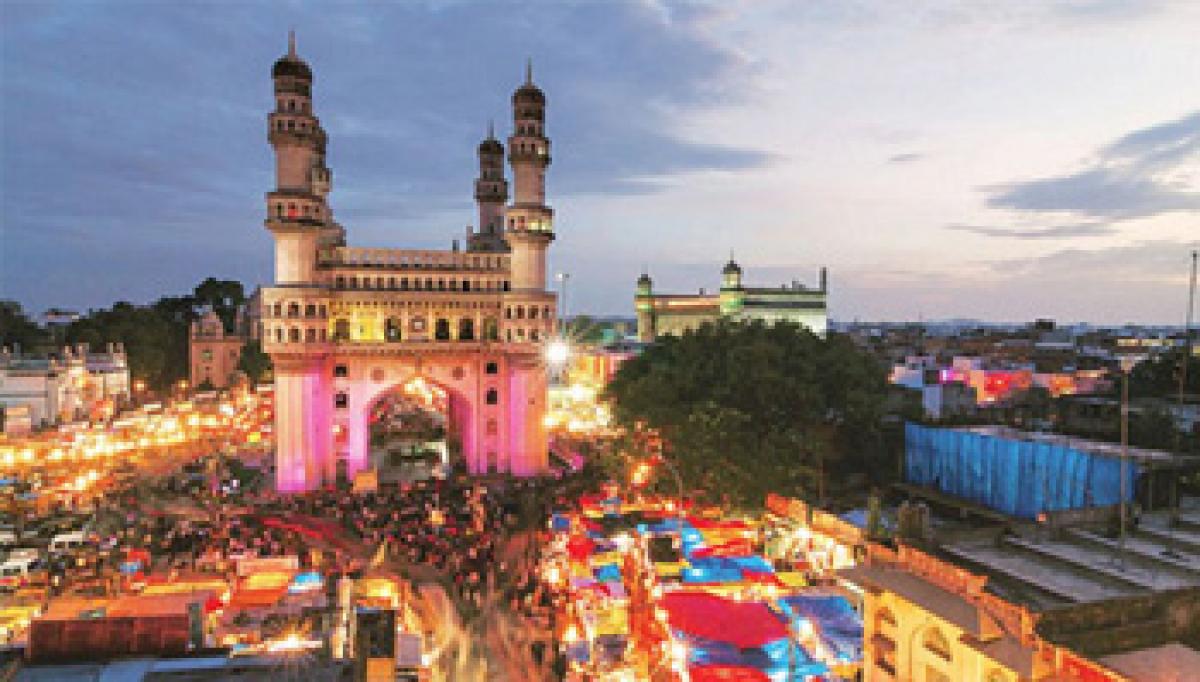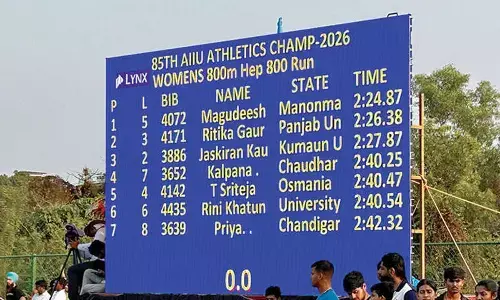Hyderabad as a global city

Hyderabad as a global city. The 19th century was the century of empires; the 20th century was the century of countries and the 21st century will be the century of cities. President Pranab Mukherjee has rightly said, \"Hyderabad is not just state headquarters or capital city.
.jpg) A great assimilation of all cultures, a strong presence of top-class R&D institutions, a fast-growing IT sector, expanding education hub – all these make Hyderabad a vibrant city. Yet, multitude of problems like pollution, slums and infrastructural bottlenecks hold back the throbbing city from emerging as a true global city. Resolution of these issues, creation of a further strong industrial eco-system and the success of the ambitious ITIR region plan – with a potential to attract Rs 2 lakh crore investments – would ensure rapid transformation of the city into a key global city. Let Hyderabad prosper for the prosperity of the State, the nation and the world
A great assimilation of all cultures, a strong presence of top-class R&D institutions, a fast-growing IT sector, expanding education hub – all these make Hyderabad a vibrant city. Yet, multitude of problems like pollution, slums and infrastructural bottlenecks hold back the throbbing city from emerging as a true global city. Resolution of these issues, creation of a further strong industrial eco-system and the success of the ambitious ITIR region plan – with a potential to attract Rs 2 lakh crore investments – would ensure rapid transformation of the city into a key global city. Let Hyderabad prosper for the prosperity of the State, the nation and the world
The 19th century was the century of empires; the 20th century was the century of countries and the 21st century will be the century of cities. President Pranab Mukherjee has rightly said, "Hyderabad is not just state headquarters or capital city.
It is something more, that as cyber city or hi-tech city. It developed the core competence of modern-day civilization - information technology.” The city has emerged as an educational hub to the benefit of not only people of this region or Telangana or Andhra Pradesh but to the benefit of whole of India. Hyderabad has its national importance.
President’s remarks assumed political significance due to the context in which the two State governments are locked in an altercation over the Section 8 of the AP State Reorganisation Act. Leaving aside the context and the wise advice rendered by the first citizen of the country, especially on his customary visit to the city, the fact remains that the Hyderabad is and will be a global city.
The city has a history of assimilating diverse cultures which is the first prerequisite to be a global city. Besides this hoary past, the city is fast acquiring economic muscle to qualify to be a true global city. The Socio Economic Outlook 2015, brought out by the Government of Telangana, has observed: “The information technology revolution, economic globalization and the political leadership have been catalyst in nurturing Hyderabad as one of the nerve centers of global economy.”
Chief Minister K Chandrashekar Rao is also repeatedly expressing his government’s commitment to transform the city into an international metropolis. KCR said, “Hyderabad is geographically safe — with zero chance of earthquakes — and has an ideal climate. Hyderabad is one among the five big cities in the country. Such a big city should be made beautiful and developed in all spheres to make it an international city.”
In the early phase of its modern growth, the city could attract huge public sector investment. Key and strategic industries in defence, electronics, pharmaceutical, heavy electrical, machine tools, alloys, etc., have come up in public sector. Besides, the city is the home to dozens of research organizations of national repute. In the recent phase, the IT growth turned Hyderabad into India’s Silicon Valley.
This paradigm of development has opened up employment and investment opportunities to people from across the country. The Telangana region was in fact ill-equipped to garner a lion’s share of fruits of such a growth. This model of growth has certainly strengthened the city’s cosmopolitan character, but the flipside of it is that Hyderabad is plagued by uneven geography of development further complicated by demographic changes.
The unprecedented urban growth levied enormous pressure on the civic resources especially on its infrastructure like roads, water supply, waste management etc. The city was converted into a concrete jungle endangering the climatic advantages it always possessed. The city needs huge investment in physical and social infrastructure to cope up with the demands imposed by the transformation into a global city.
The Government of Telangana is in the process of preparing a “vision document to make Hyderabad a global city.” The work is in the tendering stage. Apart from the global city plan, the vision document will encompass various interventions , physical and social infrastructure developments. The new industrial policy framework acknowledges the need for revitalising the industrial scenario of Hyderabad.
The new industrial policy framework emphasises on reinventing Hyderabad’s industrial eco system. Particular emphasis has to be laid on using Hyderabad as a growth engine to positively impact the entire state. The Centre has approved the setting up of a 202-square kilometer IT Investment Region (ITIR) in and around Hyderabad with an investment potential of over Rs 2.19 lakh crore and potential of creating 15 lakh direct jobs.
The ITIR would comprise areas such as Cyberabad Development Authority (CDA), including Gachibowli and Madhapur, Hyderabad Airport Development Authority (HADA) area including Mamidipalli, Raviryal, Adibatla and Maheswaram as well as the Uppal and Pocharam belt. The ITIR project would further consolidate the IT sector in the city, adding to the geography and economy of the city. The city has to develop an efficient, reliable and affordable public transport system to measure up to the needs of contemporary growth.
Out of about 8 million motorised trips in the city, the share of public transport is a low 44%. At present, there are over 3 million vehicles and about 0.2 million vehicles are getting added every year, causing frequent traffic jams and leaving the city polluted. Experts in the field suggest that about 70 per cent of the city commuters should use public transport to make it an ideal city. It is a long way to go for Hyderabad to reach this ideal level.
The Approach Paper to the 12th Plan of the Planning Commission said, “The process of urbanization is a natural process associated with growth…Agglomeration and densification of economic activities (and habitations ) in urban conglomerations stimulates economic efficiencies and provide opportunities for earning livelihoods. Possibilities for entrepreneurship and employment increase when urban concentration takes place, in contrast to the dispersed and less diverse economic possibilities in rural areas.
This enables faster inclusion of more people in the growth process and therefore more inclusive. There is synergistic relationship between rural prosperity, and the continuum of urban development from small towns through larger cities to metros. A holistic approach to spatial development is needed for inclusive growth. The growth of Hyderabad as an international city would thus contribute significantly to the prosperity of Telangana State and to the overall economy of the country.
The sluggish employment growth and the mushrooming of slums have further worsened the infrastructural situation in the city. Therefore, the urgent task is to step up investment in new infrastructure assets and maintenance of assets. Apart from the hard infrastructure, soft infrastructure should also be strengthened along with the strengthening of governance structures; deficiencies in the capacity of human and organizational resources to deal with the challenges of city’s growth must be addressed.
The satellite towns with proper connectivity would help in decongestion. The urban poor suffer from multiple deprivations such as lack of access to safe drinking water, basic sanitation , education, health care, social security, housing etc. The poor and the vulnerable are not sufficiently represented in the urban governance process, too. The city’s development process should be environmentally sustainable The National Mission on Sustainable Habitats seeks to make cities sustainable through improvements in energy efficient buildings management of solid waste and shift to public transport.
The concept of Green Buildings should be embedded into the planning process. The building norms should accordingly reflect these concerns. The erosion of green cover, the congestion of cities, the growing construction of activity, the large-scale emission of green house gases and chloro fluoro carbons have all contributed to the environmental degradation. The process of making city environmentally sustainable should include improved water management , recycling of waste water, equity and efficiency in water use.
The growth of real estate, especially the operation of speculative forces, made housing a serious problem. The community housing schemes need to be encouraged. As Mark Zuckerberg said, “There is a huge need and a huge opportunity to everyone in the world connected, to give to everyone a voice and to transform society for future.” Let Hyderabad prosper for the prosperity of the State, the nation and the world.

















